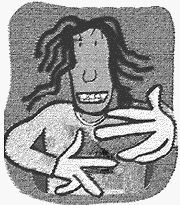BLAMING MUSIC FOR social ills— especially violence—is nothing new. As early as the turn of the century, ragtime music was seen as the cause of everything from race riots to domestic violence to general dissatisfaction with life. Witness this 1914 editorial (quoted in Edward Berlin’s excellent book Ragtime): “Let us take a united stand against the Ragtime Evil as we would against bad literature, and horrors of war or intemperance and other socially destructive evils. . . . Avaunt with ragtime rot! Let us purge America and the Divine Art of Music from this polluting nuisance.”
Now I don’t know about you, but when I think of ragtime, I think of jaunty piano music. So why were people so scared? Good question.
Ragtime’s pedigree is both bizarre and uniquely American (two qualities that rarely contradict each other). In the mid-19th century, one of the most popular forms of entertainment was the minstrel show, in which white people would paint their faces black and perform totally misinformed versions of black music and dance forms. After the Civil War, African American musicians took an increasing role in the minstrel performances. That’s right: Black people—in blackface—imitating white imitations of black music. But they brought with them a new outlook, which included sophisticated African polyrhythms and sly humor, turning the racism of the minstrel show against itself. By the end of the 19th century, people began to recognize the new style from its choppy, offbeat rhythm, its “ragged time.” For all its strange implications, though, ragtime was the first form of American music to enthusiastically throw black and white cultures together. Of course, not everyone saw this as a step forward.
This was an era in which D.W. Griffith’s racist fantasy “Birth of a Nation” defined narrative film, a time when black men were being lynched at a rate of about 100 per year and the right to vote was being rapidly taken away from African Americans across the country. It wasn’t an environment that celebrated joyful race mixing, and ragtime was a symbol for the influence of African American culture in the United States— especially for racist whites.
Ragtime, it was felt, was vulgar; its lyrics spoke with disdain about monogamous relationships and regular jobs. Ragtime evoked a world of easy sexuality and quick violence. These elements were always cartoonishly presented, but, then as now, angry critics rarely notice the humor in things.
Unfortunately, the minstrel legacy makes it difficult to quote ragtime lyrics at length. Despite the fact they were written by African Americans, the lyrics are so racist that it’s hard for a modern reader to focus on the violence, which is tame by today’s standards. From a contemporary vantage point, it seems odd that the many outrageous stereotypes would be overlooked for a few modest knifings, but take it as a sign of the times. Suffice it to say that most lyrics were first-person accounts of men fighting over gambling, men fighting over women, or men just fighting for no particular reason. Often lyrics describe a developing conflict and end climactically with the threat of violence. As one song put it, any man “that tries to win this girl of mine . . . my razor’ll seal his doom.”
ON A MUSICAL LEVEL, critics argued that ragtime was all rhythm and no melody. To those raised on European music, which tends to emphasize harmony, African-influenced music seemed to be flaunting its rhythm. Why was this bad? One opinion was that, since it offered musical “cheap thrills,” it hurt its listeners’ ability to appreciate “good” music. Another fear was that ragtime might even be physically harmful; wild rhythms could—some doctors reported—cause an irregular heartbeat.
In hindsight, it is clear that people were merely projecting their social and political concerns onto a relatively benign musical form. Social upheaval leads to fear, and fear knows no boundaries. Whites were threatened by increased black political power, which in the whites’ eyes pointed to a threat of violence. When those emotions erupted into song lyrics, the music itself became the enemy.
The idea that ragtime music could be the downfall of American culture has melted away so completely that few even remember that ragtime ever existed. But its legacy remains very much with us. In the wake of the Littleton shootings, song lyrics that reflected a commercialized vision of teen angst became the very cause of adolescent isolation. And there are those, like C. Delores Tucker and Calvin Butts, who believe that hip-hop music is currently the most dangerous problem threatening African Americans. How will these controversies look to our grandchildren? I suspect they will look a lot like ragtime looks to us—paper tigers and straw men.





